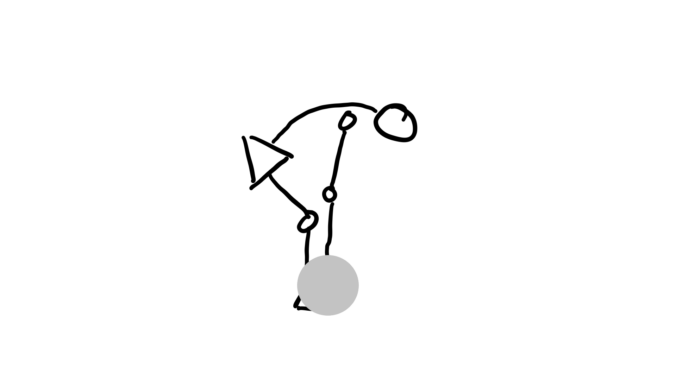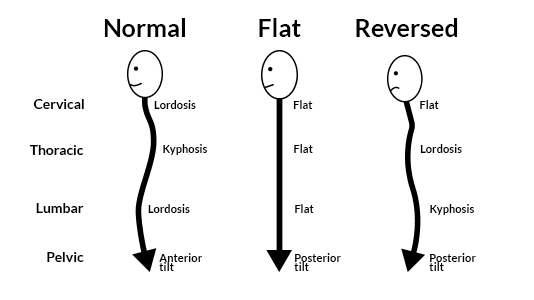Spine posture determines the body’s ability to function.
Flat spines, for example, are good at supporting heavy loads, but bad at mobility.
In this article, I want to do a deep dive into the various spine postures and why the body adopts them.
Comparing Spine Postures
Deviation from the “normal” spinal curve reduces mobility, but is sometimes still desirable. For example, you want a flat spine when supporting heavy weights, but this will limit your squat mobility.
Normal Spine Posture
The spine has a wavy shape that dictates functional differences between the various segments of the spine. There are five segments in total: coccyx, sacrum, lumbar, thoracic, and cervical. The coccyx and sacrum pieces fuse as we develop into a human, so we usually only discuss the top three segments: lumbar, thoracic, and cervical.
Each segment adopts one of two types of curvature: lordosis or kyphosis.
Kyphosis is known as a primary curve because we see it first, i.e., in fetal development. Lordosis is a secondary curve that forms after birth.
Normal spine curvature in standing is 45 degrees of lumbar lordosis (cite), 40 degrees of thoracic kyphosis (see previous citation), and 34 degrees of cervical lordosis (cite). This research article from 2018 examines individual differences in lumbar lordosis if you care to dive deeper.
In general, when we talk about a “neutral” spinal position, we’re aiming for this normal curvature.
Flat Spine
When these normal, complementary curves of the spine are eliminated, the spine is straight and flat.
This reduces mobility through the spine AND every other joint in the body.
This posture is beneficial for supporting heavy weights, like during squats and deadlifts, but detrimental for rest and recovery.
Reversed Curve
When the spine’s normal curvature is flipped, we say the spine is reversed. This happens when the back is flattened for stability, but then mobility is challenged past what is possible. This position is always undesired as it limits both mobility AND stability.
In fact, the reversed spinal curve is the essence of butt wink: thoracic extension and lumbar flexion.
This curve is generally a product of poor technique. You see it most often in lifters misusing cues such as “keep your chest up” and “keep your back arched”. Excessive arch in the spine steals hip flexion mobility, so the lumbar spine ends up rounding in the bottom half of the movement. This allows the lifter to squat lower, but compromises their stability and spine health.
Round Back
The round back is characterized by flexion at all sections of the spine.
This is NOT a common standing posture because it requires too much energy to maintain, but it can be useful when doing abdominal exercises.
Arched Back
The arched back is an excessive anterior pelvic tilt, excessive lumbar lordosis, flattening of the thoracic spine, a hinge at the base of the neck, and a flattening of the cervical spine.
This is one of the most common standing postures. It’s attributable to “standing up straight” or being highly alert for long periods of time.
This position steals mobility from the spine AND every other joint in the body. It also promotes hyperventilation while impairing rest and recovery, but that’s a topic for another day.
Sway Back
The sway back, swayback, or swayed back posture is perhaps the most common undesired spinal posture. It worsens with age and fatigue.
This posture conserves energy by resting the body’s weight on the organs, joints, and ligaments instead of using muscle to stay erect.
The sway is complicated because the upper back looks hunched, but closer examination generally shows flattening of most of the upper back with a hinging hypermobile section in the middle back which is responsible for the apparent rounding.
Summary of Spine Postures
Understanding the anatomy of the various spine postures helps you understand WHY the body wants to move that way. The nuances are important.
Sometimes the spine posture is actually desired even if it’s negatively affecting movement.
Figuring out WHY the body is moving this way can point you toward the real problem that must be addressed.









Add some color to this commentary.